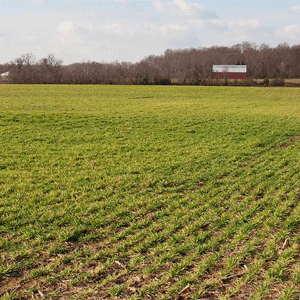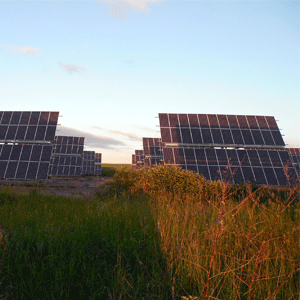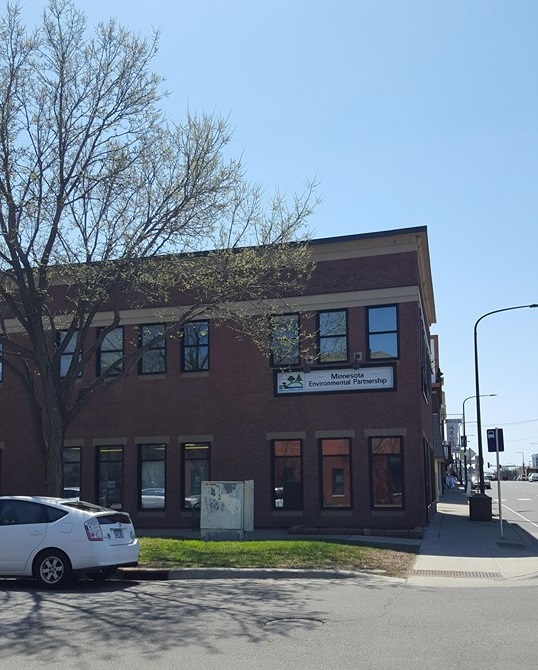|

Professor Don Wyse demonstrates the environmental challenge of uncovered cropland in the Midwest.
University of MN, MEP, and others share story of crops that help keep water clean
Over 40 people from around the country went on a field tour of the University of Minnesota’s innovative cover and perennial crops as part of the US Water Alliance’s annual One Water Summit held in Minneapolis last week. Researchers, regulators, policymakers, and other water experts saw firsthand the fruits of the UMN Forever Green Initiative, which develops valuable new crops that are both profitable for farmers and highly beneficial for the health of soil and water.
MEP Executive Director Steve Morse explained that nutrient runoff – especially nitrogen – was worsening water quality around the state and region. Efforts to increase the efficiency of nitrogen fertilizer use will only address one small slice of the problem. “We have focused heavily on managing the use of nitrogen,” Morse said, “but if we want to get to our water quality goals, we have to include continuous living cover on our agricultural lands as part of the solution.” Perennials and cover crops establish ongoing and extensive root structures that foster important microbes, absorb and supply nutrients to the plants and soil, and increase the soil’s water holding capacity.
UMN Professor Don Wyse, co-leader of the Forever Green Initiative, explained how their work is focused on developing crops to meet both economic and environmental sustainability. One major problem, Wyse said, was that “We only have green cover, capturing water and carbon pollution, in the Midwest for two and a half months out of the year.” (Shown in above photo.) Forever Green, he added, is developing cover crops like pennycress and perennials like intermediate wheatgrass that will provide year-round cover for the soil and be a new source of economic growth for farmers and businesses.
The tour took attendees from the Cargill Building to the campus crop fields, where they were able to view these developing crops in person. Professor Jake Jungers showed fields where intermediate wheatgrass – trade named Kernza™ – was growing successfully. Jungers detailed the agronomics and genome research from various partners that was continually developing Kernza into a successful perennial crop that would provide ecosystem services – like filtering water, fertilizing soil, and capturing water – all year round. At a second site, researcher Katherine Frels introduced the attendees to the University’s pennycress program. The program has made enormous progress on breeding a cover crop that would augment existing row crops and be highly usable for food and fuel.
The final stop on the tour brought the visitors to Bang Brewing, a local St. Paul business that makes use of Kernza in multiple brews. After sampling Kernza-based beer as well as dessert bars from Birchwood Café, the attendees heard Bang Brewing co-owner Sandy Boss Febbo share the brewery’s story of success implementing sustainable, water-friendly ingredients and inspiring other businesses to do the same.
Underscoring the financial potential of these crops, Shannon Shlecht, head of the Agricultural Utilization Research Institute, shared how his organization worked with researchers and businesses to develop pathways for these new crops to find success at every economic level, from farm to consumer. And Laura Hansen, a senior research scientist at General Mills, explained how companies like hers are preparing to release consumer products using Kernza, and working with partners to increase the overall Kernza supply. “It’s easy with Kernza,” she said, “because fortunately, it tastes really good!”
Minnesota has work ahead to reach our water quality goals, but if we help cutting edge crops like Kernza and pennycress enter the mainstream and integrate with our farming system, we can make rapid, lasting progress toward keeping our water clean for every Minnesota.

photo credit: Chesapeake Bay Project |
Field day shows off use of cover crops
(From Austin Daily Herald) — For more than 19 years Tom Cotter and his family have made extensive use of the practice of planting cover crops to ensure a healthier soil for his crops. On Tuesday afternoon, farmers from both Minnesota and Iowa, along with other people in the ag industry, converged on the Cotter farm to see and hear first hand from Cotter the positive effects cover crops have had on his farming operation as well as insight into the practice itself. Over 90 people took part in the event. Visitors listened to presentations and took a trip to Cotter’s fields as well as those of another nearby farmer, Jon Jovaag. For Cotter, it was important for farmers considering the move to organic farming and the planting of cover crops to see it first hand. “That’s where they realize they can take it to their field,” Cotter said. >>Read More.
|

|
 |
Nominations open for Midwest Energy News’ 40 Under 40 Awards
Each year, Midwest Energy News recognizes Midwest-based leaders and innovators from all sectors— industry, government, regulatory, business, academia, nonprofit, and advocacy. Those selected are invited to the Honorees Reception in Chicago to celebrate and network with the prestigious advisory committee and past award recipients.
Midwest Energy News is now seeking nominations! Honorees are both self-nominated and nominated by peers. Visit the 40 under 40 web page to nominate a leader you believe is worthy of recognition.
|
 |
Blue Earth County OKs solar array north of Eagle Lake
(From Mankato Free Press) — In the end, no one got quite what they wanted with a community solar array set to go north of Eagle Lake. The Blue Earth County Board of Commissioners signed off on a proposed relocation and conditional use permit for FastSun 14 LLC, which plans to put a 1-megawatt solar farm on the corner of County Road 27 and 223rd Street. Commissioners aren’t letting FastSun 14 move the array closer to the street, which is what the company had hoped for. The array will move slightly south and back about 460 feet from the roadway to address concerns from nearby neighbors. In addition, the company is required to screen the array off by planting trees no more than 8 feet apart on the array’s north, west and south side. >>Read More.
|

|
 |
Statewide View: Minnesota can take lead in stomping out plastic pollution
(From Duluth News Tribune) — Starbucks has moved to phase out plastic straws. The company announced July 9 it would eliminate plastic-straw use in all its stores by 2020. The transition will feature new lids that do not require straws and eco-friendly straws for certain drinks. Minnesota must keep up the momentum created by this milestone decision. Plastic pollution is a growing hazard for marine ecosystems and public health. It affects all bodies of water. Minnesota needs to implement a statewide ban to eliminate single-use plastics such as polystyrene. Our culture of consumption encourages people to use and discard, often leaving our waterways to face the consequences. >>Read More.
|
 |
Line 3 still has regulatory ground to plow before bringing in bulldozers
(From MPR News) — Before Enbridge Energy can bring in the bulldozers and backhoes to build its Line 3 pipeline across northern Minnesota, it still has to go through more months of regulatory scrutiny. The project took a big step forward late last month when it won approval from the Minnesota Public Utilities Commission after nearly four years of review — but it was by no means the last hurdle the controversial project faces. Gov. Mark Dayton’s office has tallied 29 more approvals needed before construction can start. >>Read More.
|
Help sustain MEP’s work. Donate today!
Do you appreciate our coverage of environmental and conservation issues? You can help sustain MEP’s work with a donation. Your support will help MEP continue educating decision-makers and Minnesotans throughout the state about important issues that impact clean water, clean air, and land conservation. Contributions also provide the financial backing we need to help organize the advocacy efforts of our 70 member organizations and take action through public organizing, media campaigns, lobbying, and research.
|

|
 |
Office space available in MEP’s building!
Is your organization in the market for a convenient, comfortable office space in St. Paul? The office suite above MEP’s office at 546 Rice Street is available for lease! The approximately 2200 square ft. space is ideal for a small to midsize nonprofit organization, featuring a kitchen and break area and offstreet parking.
Located in the Capitol-Rice Street neighborhood, it is also within three blocks of the Capitol complex and across the street from the Women’s Building. It is also positioned along bus routes 3, 62, and 67, and a two-minute walk from the Green Line. And perhaps best of all, the new tenant would have good neighbors in MEP’s staff!
The landlord may be open to letting portions or the entirety of the office space to individual organizations. Contact us for details!
Please contact Matt Doll at matthew@mepartnership.org if interested.
|
Weekly Environmental Trivia – Answers Below Job Postings!
|
 |
1. What is the world’s most-produced crop by weight?
2. What is the second most-produced crop in the United States by weight?
3. How many national monuments can be found in Minnesota?
|
Upcoming Environmental Events
“Three Minnesota Futures: A Future to Fear, A Future to Plan For, & A Future to Fight For,” July 19
Climate Change Info presentation by Sam Potter, at Maple Grove Library
Hosted by NW Metro Climate Action
LSP Western Minn. Local Foods Dinner Fundraiser, July 21
Swift Falls County Park, Swift Falls
Hosted by Land Stewardship Project
See the film “Happening: A Clean Energy Revolution,” July 22
Davanni’s in Woodbury
Hosted by Southeast Metro Climate Action
LSP Prairie Pothole W. Minn. Bike Ride Fundraiser, July 22
Morrison Lake State Park, Sunburg
Hosted by Land Stewardship Project
6th Annual Love Water Not Oil Tour and the “Water is Life Festival”, July 22
Bayfront Festival, Duluth
Hosted by Honor the Earth
Pollinator Festival, July 28
Bruce Vento Nature Sanctuary, St. Paul
Hosted by Lower Phalen Creek Project
Jobs and Volunteer Opportunities
Stop Factory Farms Organizer | Land Stewardship Project
Finance Manager | The Nature Conservancy in MN, ND and SD
Deputy Director of Habitat Protection | The Nature Conservancy in MN, ND and SD
Political Program Intern | Sierra Club North Star Chapter
Executive Director | Leech Lake Area Watershed Foundation
Energy Efficiency Specialist | MN Chamber of Commerce – Waste Wise and Energy Smart Program
Conservation Program Manager | Minnesota Land Trust
Education Program Supervisor | Minnesota Trout Unlimited
Senior Policy Associate, Electrification | Fresh Energy
Organizing Representative – Duluth | Sierra Club North Star Chapter
Data Manager | Minnesota Center for Environmental Advocacy
See all job postings
Trivia Answers: 1) Sugar cane. 2) Soybeans. 3) Two – Pipestone and Grand Portage.
|
|
|